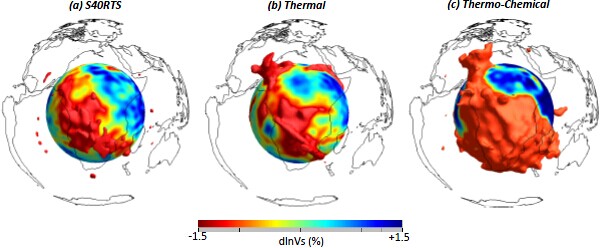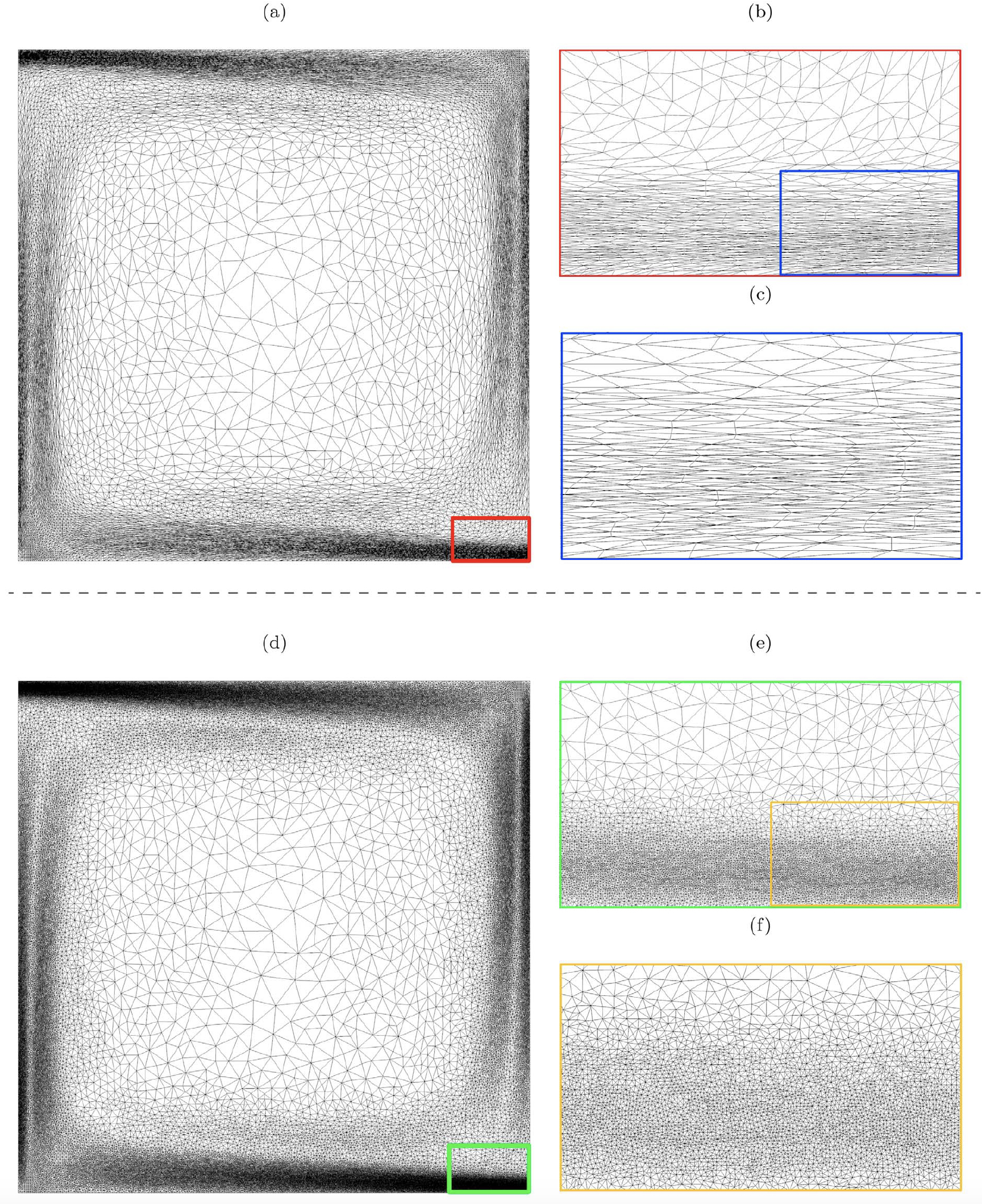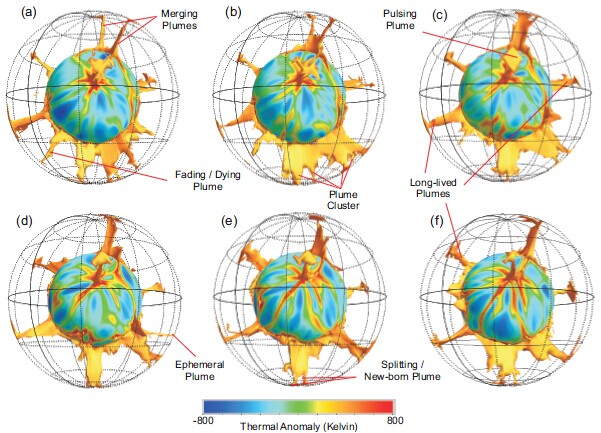Professor Rhodri Davies

Content navigation
About
I am a computational geodynamicist, internationally recognised and awarded for research that links the evolution of Earth’s surface to dynamical processes within its interior. I have developed some of the most advanced tools available for simulating geodynamical processes and used these, alongside a variety of observational datasets, to enhance understanding of mantle dynamics and its signature at the surface, across a range of spatial and temporal scales.
Positions Held
2023 - Present: Professor, RSES, ANU.
2023 - Present: Associate Director (Research & Engagement), RSES, ANU.
2019 - 2022: Associate Professor, RSES, ANU.
2018 - 2021: Associate Director (Honours & Masters), RSES, ANU.
2015 - 2018: ARC Future Fellow, RSES, ANU.
2013 - 2014: Research Fellow, RSES, ANU.
2010 - 2012: NERC Research Fellow, Imperial College London.
2009 - 2010: 1851 Research Fellow, Imperial College London.
2008 - 2009: Research Assistant, Funded by Shell, Based at the School of Earth & Ocean Sciences, Cardiff University.
Awards
2025: Education: Bear McPhail Excellence in Teaching Award, Research School of Earth Sciences, The Australian National University. Recognises excellence in teaching. Awarded based upon long-term outstanding contributions to the undergraduate and graduate education programs at RSES.
2022: Education: Senior Fellowship of the Higher Education Academy. Recognises attainment against UK professional standards framework for teaching and learning support in higher education.
2022: Research: Harold Jeffreys Lecture, The Royal Astronomical Society. This prestigious lecture is awarded annually to an authoritative and engaging speaker on a suitable topic in geophysics.
2021: Education: Dean's Commendation for Excellence in Education, College of Science and Medicine, The Australian National University. Recognises significant contributions to the development and delivery of undergraduate and graduate teaching programs at RSES.
2021: Education: Bear McPhail Excellence in Teaching Award, Research School of Earth Sciences, The Australian National University. Recognises excellence in teaching. Awarded based upon long-term outstanding contributions to the undergraduate and graduate education programs at RSES.
2018: Research: Anton Hales Medal, The Australian Academy of Sciences. Recognises distinguished research in the Earth sciences,
2016: Education: Fellowship of the Higher Education Academy. Recognises attainment against UK professional standards framework for teaching and learning support in higher education.
2015: Media & Outreach Award, The Australian National University.
2014: Research: Outstanding Young Scientist Award: European Geosciences Union, Geodynamics Division. Recognises substantial, original and significant contributions to global geodynamical research.
2014: Strategic Communications & Public Affairs Award, The Australian National University.
Funding and Fellowships
2025: ARC Discovery Project (DP220100173 - Davies, Seton, Hoggard, Whittaker). Volcanoes on Ice: Mantle influence on Antarctic Ice Sheet Inception and Evolution.
2024: AuScope Platform Grant - CoastRI GIA modelling (Davies, Ghelichkhan, Gibson, Hoggard, Kramer).
2022: ARC Discovery Project (DP220100173 - Davies, Muller, Sambridge, Goes, Rawlinson). Earth’s Dynamic Topography through Space and Time.
2021: ARC Australian Centre for Excellence in Antarctic Science (ACEAS, SR200100008, King et al).
2021: ARDC Platform Grant - G-ADOPT - Geodynamic ADjoint OPTimization Platform.
2020: ARC Linkage project (LP190100635 - C. Spandler, J. Mavrogenes, D. R. Davies, T. Ubide, D. Huston, N. Rawlinson, P. Blevin, H. Degeling, S. Morin-Ka and R. Wilson). Realising Australia’s Rare Earth resource potential. Partners: Geological Survey of NSW; Department of Natural Resources, Mines and Energy; Geological Survey of Western Australia; Northern Minerals Ltd.
2020: ARC Discovery Project (DP200100053 - Valentine, Sambridge and Davies). Seeing the Unseeable: A New Generation of Geophysical Imaging.
2018: Geoscience Australia Research Partnership - Exploring for the Future Program - Probing the Lithosphere using Mafic Geochemistry.
2017: ARC Discovery Project (DP170100058 - Davies, Campbell and Kennett). Earth's Intra-Plate Volcanic Engine.
2014: ARC Future Fellowship (FT140101262 - Davies). From Plume Source to Hotspot: Quantifying Mixing in Mantle Plumes and its Implications for the Nature of Deep Mantle Heterogeneity.
2012: NERC Standard Grant (UK) - The Mantle Transition Zone `Valve'.
2011: NERC Post-doctoral Research Fellowship (UK) - Pulsing Mantle Plumes: Causes and Geological Consequences.
2009: Research Fellowship - Royal Commission for the Great Exhibition of 1851 (UK) - Modelling Earth's Engine: Innovative Techniques for Simulating Thermo-chemical Mantle Convection.
2009: Research Grant - Shell International Exploration and Production (UK) - Integrating Convection Models, Tomographic Observations and Tectonic Reconstructions.
Affiliations
- Geophysics, Member
Research interests
I am recognised for developing and integrating state-of-the-art tools that simulate mantle and lithosphere dynamics, with a diverse range of observational datasets, to significantly enhance understanding of mantle and lithosphere dynamics and their signature at the surface, across a range of spatial and temporal scales.
Research overview
My research focusses upon the dynamics of our planetary heat engine – the mantle – and its geophysical, geological and geochemical expression, across a range of spatial and temporal scales. I have developed some of the most advanced tools available for simulating geodynamical processes and have used these tools, alongside a variety of novel observational datasets, to significantly enhance our understanding of mantle and lithosphere dynamics and its signature at the surface.
My long-term vision is to develop a new paradigm for solid Earth evolution. The overarching goal is a reconstruction of the thermo-chemical structure and flow history of Earth’s mantle and its evolution through space and time (4-D). To achieve this, I am working towards developing ‘inverse geodynamics’, to fuse wide-ranging constraints from geophysics, geology and geochemistry with multi-resolution computational modelling. The key outcome will be a unified quantitative understanding of plate tectonics and the thermo-chemical state of Earth’s mantle in 4-D. This will reveal the interplay between the deep Earth, the lithosphere and its surface, and the physical and chemical processes that govern the tempo and multi-scale nature of Earth’s evolution, addressing a widely recognised grand challenge for the Earth Sciences. Success will require a collaborative network of scientists from several fields, including numerical modellers, inverse theorists and observational scientists. It will engage a broad cross-section of academic staff and graduate students. I am always looking for motivated and enthusiastic students to join the group.
Key focus areas of my current and future research, include:
- Isolating the mechanisms underpinning intra-plate volcanism on Earth, by combining cutting-edge geodynamical models with seismological, geochemical and petrological constraints – this research has already produced game-changing results, published in Geology and Nature (2015, 2017), the significance of which was formally recognised through the 2018 Anton Hales Medal from the Australian Academy of Sciences.
- Revealing how Earth’s surface topography responds to underlying mantle flow (dynamic topography), by reconciling observational constraints on residual topography with theoretical predictions – our recent research in this space (Nature Geosciences, 2019), provides fundamental insight into present-day dynamic topography that will underpin our ongoing efforts to reconstruct its spatio-temporal evolution.
- Quantifying the force-balance governing surface tectonics and rapid plate motion changes, utilising our unique coupled models of mantle and lithosphere dynamics – although it is often overlooked, our ground-breaking research in this area, which includes a 2018 publication in Nature Geosciences, highlights the key role of mantle flow in governing surface tectonics.
- Reconciling key geophysical and geochemical constraints on mantle structure, by validating synthetic models of mantle structure, dynamics and evolution, against diverse geophysical and geochemical datasets – this builds on almost a decade of theoretical, methodological and applied research, the novelty and significance of which was emphasized in the citation for my 2014 outstanding young scientist award from the EGU.
Fundamental progress on each of these goals relies on the development and application of `inverse geodynamics’, to fuse wide-ranging constraints from geophysics, geology and geochemistry with multi-resolution computational modelling.
Research tools
I am leading a large cross-NCRIS (ARDC, AuScope, NCI) platform project to develop transformational new research software infrastructure fo inverse geodynamics. More information can be found on this so-called G-ADOPT framework here. G-ADOPT is a computational platform for inverse geodynamics, which we develop and maintain at the Research School of Earth Sciences (RSES). It builds on a recent surge in accessible observational datasets and advances in inversion methods using sophisticated adjoint techniques, which provide a mechanism for fusing these observations with dynamics, physics, and chemistry. The resaerch software infrastructure is centered upon Firedrake.
I am also a long-standing developer of Fluidity. This computational modelling framework, which I've been developing and using since 2009 alongside collaborators in the UK and USA, allows for a novel style of geodynamical modelling based upon adaptive, anisotropic, unstructured meshes, in which the resolution of the computational grid is automatically increased or decreased as required by the nature of the solution. Through this approach, it becomes possible to achieve efficient inclusion of the wide range of spatial-scales required to simulate important processes in mantle convection, for example, high resolution subducting slabs and upwelling plumes amongst a coarser resolution and more passive background mantle.
Research highlights
Davies et al., Geoscientific Model Development (2022) - Towards Automatic Finite Element Methods for Geodynamics via Firedrake. Firedrake is an automated system for solving partial differential equations using the finite element method. It treats finite element problems as a composition of several abstract processes and, by applying sophisticated performance optimisations through automatic code-generation techniques, provides a means to create accurate, efficient, flexible, easily extensible, scalable, transparent, and reproducible research software. In this paper, we demonstrate the applicability of Firedrake for geodynamical simulation, with a focus on mantle dynamics. We illustrate how Firedrake creates a separation of concerns between employing the finite element method and implementing it: this is a game-changer, as it opens up these problems to a new class of user and developer. The transformational nature of this approach has been recognised by the Australian research community and government partners alike. As a result, I now lead a substantial cross-NCRIS platform grant in partnership with the ARDC, AuScope, and the NCI, to further develop and support this research software infrastructure. It will facilitate robust data-driven geodynamical simulation.

Present-day thermal structure, predicted from a global mantle convection simulation in Firedrake where the geographic distribution of heterogeneity is dictated by 230 Myr of imposed plate motion history (from Muller et al. 2016). Each image includes a radial surface immediately above the core-mantle boundary, a cross-section, and transparent isosurfaces at temperature anomalies (i.e. away from the radial average) of T=-0.075 (blue) and T=0.075 (red), highlighting the location of downwelling slabs and upwelling mantle plumes, respectively. Continental boundaries provide geographic reference. Panel a provides an Africa-centered view, with panel b centered on the Pacific Ocean, and including (green) glyphs at the surface highlighting the imposed plate velocities.
Davies et al., Nature Geosciences (2019): we combine observational constraints on residual topography beneath the world’s oceans with an innovative statistical approach to performing spherical harmonic analyses to generate a robust estimate of the power spectrum of Earth’s oceanic residual topography. We demonstrate that theoretical predictions can only be reconciled with the resulting spectrum if they incorporate the effects of lithospheric structure and its contribution towards global mantle flow: both deep (long-) and shallow (shorter-wavelength) processes are crucial to generating the observed surface response. Our study resolves the long-standing debate on the spatial distribution, wavelength and amplitude of present-day dynamic topography, reconciling key predictions of mantle flow models with inferences from the geological record and emphasising the key role that Earth’s deep interior plays in shaping the surface of our planet. This will underpin our ongoing efforts to reconstruct its spatial and temporal evolution.
Inferred Oceanic Residual Topography: spherical harmonic model (regularised using ARD) up to l = 30, of our updated compilation of oceanic (point-wise and ship-track) residual topography measurements. In the left panel we display the l = 0-3 components of this model.
Iaffaldano et al., Nat. Geo. (2018): plate motions are well-studied but we lack a fundamental understanding of their impact on surface processes, particularly in regions where their boundaries are relatively diffuse. Nowhere is this more clearly apparent than the Indian Ocean floor. In this study, we identify geologically recent plate motion changes in the Indian Ocean realm and provide an explanation for their occurrence and an understanding of their impact on the development of diffuse plate margins. Specifically, we link the observed plate motion change and the consequent lithospheric deformation to the Reunion mantle plume. Our results emphasise the key role that Earth’s deep interior plays in shaping the surface of our planet.
Jones et al., Nature (2017): an inter-disciplinary study, which demonstrates that the Pacific plate’s geographically and geochemically distinct double volcanic hotspot tracks, at Hawaii, Samoa, Society, Foundation and Marquesas, emerged concurrently at ~3 Ma. The study provides a novel dynamical explanation that links their emergence to a recent and previously unidentified plate motion change, and illustrates how this change produced the systematic geochemical variations observed.

Left: Bathymetric map of recent Hawaiian volcanism, highlighting the Loa and Kea tracks; Right: Schematic diagram of the tilted Hawaiian plume, the overlying Pacific plate and associated surface volcanism.
Animation highlighting the emergence of a double volcanic hotspot track, in response to a plate motion change (Jones et al. 2017).
Jones et al., EPSL (2016): we quantitatively demonstrate how deep-mantle heterogeneities are transported into a plume conduit, and determine the conditions under which deep-mantle structure can be mapped from geochemical observations at Earth’s surface.
Davies et al., Nature (2015): we identify the full-extent of Earth’s longest continental hotspot track: the Cosgrove track in eastern Australia. This study highlights a clear correlation between lithospheric thickness, volcanic outcrop and magma composition along this track, indicating that lithospheric thickness has a dominant influence on the volume and chemical composition of plume derived magmas and placing an observational constraint on the sub continental melting depth of upwelling mantle material.

In Davies et al. (2015), we identify Earth’s longest continental hotspot track in eastern Australia, the Cosgrove track, which extends from Cape Hillsborough (CH) to Cosgrove (C). Magma composition and volcanic outcrop correlate with lithospheric thickness along this track, thus constraining the sub-continental melting depth of mantle plumes. This figure shows the distribution of eastern Australian Cenozoic volcanic centers and their relationship to lithospheric thickness: (a) volcanic centers, colored using the classification of Wellman & McDougall (1974), with age-progressive hotspot-tracks denoted by black dashed lines; BU=Bunya; CA=Canabolas; CE=Central; CO=Comboyne; FI=Fraser Island; L=Liverpool; M=Monaro; MC=McBride; NU=Nulla; NVP=Newer Volcanics Province; S=Sturgeon; (b) the same centers, plotted on an estimate of lithospheric thickness, highlighting a correlation between lithospheric thickness and volcanic outcrop and classification along the Cosgrove hotspot-track.
Davies & Rawlinson, Geology (2014): an inter-disciplinary study which combines high-resolution data from the transportable WOMBAT seismic array was integrated with 3-D geodynamical models, to demonstrate that several lithospheric steps combine, because of their orientation, to localize mantle melting beneath the Newer Volcanics Province of Victoria and South Australia. Although focussed on southern Australia, the study helps to solve the global puzzle of why step-changes in lithospheric thickness, which occur along craton edges and at passive margins, only produce volcanism at isolated locations: lithospheric steps are a key prerequisite for this process, but their orientation is of equal importance, due to the role of background mantle flow.

Variations in P-wave velocity at 100 km depth, beneath the Newer Volcanics region of Southeastern Australia. The horizontal limits of volcanic outcrop at the surface is denoted by a yellow dashed line. This image comes from the inter-disciplinary seismological and geodynamical study of Davies & Rawlinson (2014), which demonstrates that recent volcanism in Australia is the manifestation of edge-driven convection. It also provides a potential solution to the global puzzle of why step-changes in lithospheric thickness produce only isolated volcanism.
Garel et al., G3 (2014): competition between overriding plate strength and tensile stresses in the subducting plate controls both trench migration rates and slab sinking rates, with important consequences for slab/transition-zone interaction.

A 2-D thermo-mechanical dynamic subduction simulation from Fluidity. Temporal snapshots of: (a) temperature; (b) viscosity; (c) the dominant deformation mechanism; and (d) the underlying computational mesh, from a case where subducting/overriding plates are initially 100/20 Myr old at the trench, respectively (black squares indicate initial trench location). White lines in panel (a) mark isotherms from 600-1400 K at 200 K intervals. Black (b/c) and red (d) lines mark the location of the 1300K isotherm. In this class of subduction model, the slab’s buoyancy and distinct rheological properties arise self-consistently, through variations in temperature, pressure and strain-rate, with deformation accommodated through a composite diffusion creep (diff), dislocation creep (disl), Peierls creep (P) and yielding (YS) law. In the example shown, the slab’s excess density drives subduction and trench retreat over time. Upon interaction with the transition zone, the descending slab temporarily stalls and deforms (b/c), before slowly sinking into the lower mantle (d). Note that throughout its descent, the slab maintains a strong core (b), which is a requirement from observations of Benioff seismicity. The underlying computational mesh is adapted at fixed intervals during the simulation, with zones of high resolution analogous to regions of dynamic significance. A local resolution of 500m is required to resolve the slab’s strong core and the interface between subducting and overriding plates (Garel et al. 2014). The Garel et al. (2014) study, funded by a NERC grant, shows how competition between overriding plate strength and tensile stresses in the subducting plate controls both trench migration and slab sinking rates, with consequences for slab/transition-zone interaction.
Davies et al., EPSL (2012): synthetic seismic structures from global circulation models demonstrate that thermal heterogeneity alone can explain observed deep mantle seismic characteristics. This has important implications for the nature and distribution of mantle chemical heterogeneity.

Shear wave velocity perturbations beneath Africa from: (a) tomographic model S40RTS (Ritsema et al. 2011); (b) a purely-thermal model; and (c) a thermo-chemical model, where the dense chemical component represents only 3% of the mantle volume (Davies et al. 2012). In the isochemical model, (T,P,X) is converted into seismic velocity assuming a pyrolitic composition, whilst the thermo-chemical model illustrated assumes a pyrolitic composition for background mantle and an iron-rich composition for the dense chemical component. The structure of a thermo-chemical model with a basaltic dense component has similar characteristics. We account for the geographic bias, smearing and damping inherent to tomographic models using the resolution operator of S40RTS, thus allowing for direct comparison between our models and S40RTS. All images include a radial surface at 2850-km depth and an isosurface at -1.0%, clipped above 1400-km to allow visualisation of lower mantle features. Continental boundaries are included for geographic reference. The Davies et al. (2012) study, fudned by a NERC post-doctoral Research Fellowship, demonstrates that thermal heterogeneity alone can explain observed deep mantle seismic characteristics. This has important implications for the nature of mantle dynamics and the likely distribution of mantle chemical heterogeneity.
Davies et al., G3 (2011): a new computational framework for geodynamical simulation, built around parallel anisotropic adaptive unstructured mesh techniques. It allows for simulations of mantle and lithospheric dynamics with an unprecedented level of realism.

(a) Anisotropic, adapted unstructured mesh (maximum element aspect ratio = 10, number of triangle vertices = 16,699), from a square convection simulation shown in Fluidity; (b, c) high‐resolution images of specific mesh sections, illustrating anisotropic elements within the thermal boundary layer; (d) a near‐isotropic unstructured mesh (maximum element aspect ratio = 1, number of triangle vertices = 94,133), with the same minimum edge length as the mesh displayed in panel a; (e, f) high‐resolution images of specific mesh sections. Placing an aspect ratio bound of 1 (isotropic) on the metric dramatically increases the number of nodes required to represent the problem.
Davies & Davies, Solid Earth (2010): a vastly improved estimate of Earth’s surface heat flux is presented, based upon GIS methodologies and an enhanced heat flow dataset. This has implications for Earth’s thermal budget and evolution.
Davies & Davies, EPSL (2009): cutting-edge global mantle convection models demonstrate that mantle plumes can reconcile a wide–range of hotspot observations, providing strong quantitative support for the mantle plume hypothesis.

A series of thermal profiles, displaying the temporal evolution of a high Rayleigh number global mantle convection simulation, with free-slip and isothermal boundaries. Snapshots are spaced 30 Myr apart and are surrounded by a latitude-longitude grid. The scale illustrates the temperature, away from the lateral average. Each snapshot shows a radial surface just above the CMB and a hot isosurface, representing regions of the mantle that are 500K hotter than average for their depth. The most prominent features are hot upwelling plumes. These display a range of characteristics. The majority are long-lived and migrate slowly across the mantle. Others are more mobile and ephemeral. New plumes form and old ones fade, some of which eventually cease. Smaller plumes merge together and coalesce over time, while long-lived plumes often pulse or vary in intensity. This snapshot comes from the study of Davies & Davies (2009), which demonstrates that mantle plumes can reconcile a wide-range of hotspot observations, providing strong quantitative support for the mantle plume hypothesis.
Davies et al., G3 (2007): first study to demonstrate applicability and benefits of adaptive mesh refinement techniques for geodynamical simulations. These schemes use intelligent algorithms to modify the computational grid automatically, enhancing resolution where required.
Projects
- Earth's Intra-plate Volcanic Engine, Principal investigator
- From Plume Source To Hotspot: Quantifying Mixing In Mantle Plumes And Its Implications For The Nature Of Deep-Mantle Heterogeneity, Principal investigator
- Pulsing Mantle Plumes: Causes And Geological Consequences, Principal investigator
- Computational Geodynamics, Supervisor
- Fluidity: the next frontier, Supervisor
- Predictive geochemical and geodynamic models of plume-lithosphere interaction, Supervisor
- High-resolution probing of the Earth’s lowermost mantle , Collaborator
Teaching information
Courses:
EMSC 3034/6034: Dynamic Earth - Plates, Plumes and Mantle Convection
Mantle convection is the fundamental agent driving many of the geological features observed at Earth's surface, including plate tectonics and volcanism. However, many geologists have an incomplete understanding of the process, whilst there are many misconceptions about how it relates to surface processes. A broad background to the physics and fluid dynamics of mantle convection will be provided in this course, by explaining what it is, how it works, and how to quantify it in simple terms. It assumes no specialist background: mechanisms will be explained simply and the required basic physics will be fully reviewed and explained. The distinctive forms that convection takes within Earth's mantle will be described within the context of tectonic plates and mantle plumes, whilst the implications for geochemistry and Earth's tectonic evolution will be explored. Common misconceptions and controversies will be addressed, providing a straightforward, but rigorous, explanation of this key process. Emerging insights into the fundamental links between climate, surface processes (weathering, erosion and sediment transport), plate tectonics and underlying mantle flow will also be covered, thus providing a complete overview of Earth’s dynamic engine.
EMSC 8034: Research Orientation - Big Questions in the Earth Sciences
A course for Master of Earth Sciences students that will reveal the biggest unanswered questions in the Earth Sciences. Students will be introduced to the breadth of science undertaken at the Research School of Earth Sciences and will gain an appreciation for the different research approaches utilised and facilities available. Further, this course will provide a framework for students to make an informed choice of research supervisor and project for their subsequent studies.
Qualifications:
2022: Senior Fellow of the Higher Education Academy (FHEA). Recognises attainment against the UK professional standards framework for teaching and learning support in higher education. This demonstrates my commitment to reflection on teaching practice and ongoing professional development. It also provides evidence of my high standing as an educator amongst my peers.
2016: Fellow of the Higher Education Academy (FHEA). Recognises attainment against the UK professional standards framework for teaching and learning support in higher education.
Location
J2, G42
Publications
For an up-to-date list of publications and associated metrics, see one of the following links.
